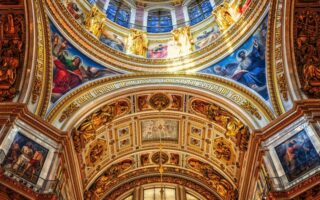The Orthodox Church and the Catholic Church split in 1054, resulting in what is known as the Great Schism. This division was primarily due to a combination of theological, cultural, and political differences that had been building up over centuries.
Table of Contents
Historical Background of the Orthodox-Catholic Schism
The Orthodox-Catholic schism is a significant event in the history of Christianity. It marked the division between the Eastern Orthodox Church and the Roman Catholic Church, two major branches of Christianity. To understand why this split occurred, it is essential to delve into the historical background of the Orthodox-Catholic schism.
The roots of the schism can be traced back to the early days of Christianity when the Church was still united. However, as time went on, differences in theology, culture, and politics began to emerge between the Eastern and Western parts of the Roman Empire. These differences gradually led to a growing divide between the Eastern and Western Christian communities.
One of the key factors that contributed to the schism was the issue of papal authority. In the West, the Bishop of Rome, also known as the Pope, held a position of great authority and claimed to be the successor of Saint Peter. The Pope asserted his primacy over all other bishops and claimed the power to make final decisions on matters of faith and doctrine. This view was not universally accepted in the East, where the authority of the Pope was seen as one among equals.
Another significant point of contention was the use of icons in worship. In the East, the veneration of icons was deeply ingrained in the religious practices of the people. Icons were seen as windows to the divine and were used as aids in prayer and meditation. However, in the West, there was a growing movement that viewed the use of icons as idolatrous. This difference in opinion on the role of icons in worship further widened the gap between the Eastern and Western Christians.
Furthermore, political and cultural factors also played a role in the schism. The fall of the Western Roman Empire in 476 AD led to the rise of various Germanic kingdoms in the West. These kingdoms had their own distinct cultures and traditions, which further differentiated them from the Eastern Roman Empire. The political and cultural differences between the East and West contributed to the growing divide between the two regions.
The final straw that broke the camel’s back was the Great Schism of 1054. This event marked the formal split between the Eastern and Western Churches. The primary cause of the Great Schism was the mutual excommunication of the Pope and the Patriarch of Constantinople, the leader of the Eastern Church. The excommunications were the culmination of years of tension and disagreements between the two sides.
In conclusion, the historical background of the Orthodox-Catholic schism reveals a complex web of theological, cultural, and political factors that led to the division between the Eastern Orthodox Church and the Roman Catholic Church. Differences in papal authority, the use of icons, and political and cultural disparities all contributed to the growing divide between the East and West. The Great Schism of 1054 was the final event that formalized the split between the two branches of Christianity. Understanding this historical background is crucial to comprehending the reasons behind the Orthodox-Catholic schism.
Key Differences in Doctrine and Theology

The split between the Orthodox Church and the Catholic Church is a significant event in the history of Christianity. While both churches share a common heritage and many similarities, there are key differences in doctrine and theology that led to the division. Understanding these differences can shed light on why the split occurred and why the two churches remain separate to this day.
One of the main differences between the Orthodox Church and the Catholic Church lies in their understanding of the nature of the Holy Trinity. The Orthodox Church believes in the procession of the Holy Spirit from the Father alone, while the Catholic Church teaches that the Holy Spirit proceeds from both the Father and the Son. This theological disagreement, known as the Filioque controversy, was one of the major points of contention that led to the split.
Another significant difference between the two churches is their approach to authority. The Catholic Church recognizes the authority of the Pope as the head of the Church, while the Orthodox Church believes in a more decentralized structure with a collective leadership of bishops. This difference in ecclesiastical governance has been a source of tension between the two churches for centuries.
The issue of papal infallibility is also a point of contention between the Orthodox and Catholic Churches. The Catholic Church teaches that the Pope is infallible when speaking ex cathedra, or from the chair of Peter, on matters of faith and morals. In contrast, the Orthodox Church does not recognize the concept of papal infallibility and believes that all bishops are equal in authority.
The role of icons in worship is another area where the Orthodox and Catholic Churches differ. The Orthodox Church places a strong emphasis on the use of icons as aids to worship and believes that they are a means of connecting with the divine. The Catholic Church, on the other hand, has had a more complex relationship with icons throughout its history, with periods of iconoclasm and debates over their use.
The issue of original sin is yet another theological difference between the two churches. The Catholic Church teaches that all humans inherit the guilt of Adam and Eve’s original sin, while the Orthodox Church believes that humans inherit the consequences of the fall but not the guilt. This difference in understanding has implications for the sacrament of baptism and the concept of salvation.
Despite these differences, it is important to note that the Orthodox Church and the Catholic Church share a common faith in Jesus Christ and the basic tenets of Christianity. Both churches believe in the divinity of Christ, the importance of the sacraments, and the need for salvation through faith and good works.
While the split between the Orthodox Church and the Catholic Church was undoubtedly a significant event in the history of Christianity, it is essential to approach the topic with respect and understanding. The differences in doctrine and theology that led to the division should not overshadow the shared beliefs and common heritage of these two great traditions. By recognizing and appreciating these similarities and differences, we can foster dialogue and unity among Christians of all denominations.
Influence of Political and Cultural Factors on the Split
The split between the Orthodox and Catholic churches was not solely a result of theological differences. In fact, political and cultural factors played a significant role in the division. Understanding these influences can shed light on why the Orthodox Church decided to break away from the Catholic Church.
One of the key political factors that contributed to the split was the rise of the Byzantine Empire. As the empire grew in power and influence, it sought to assert its own authority over the church. This led to tensions with the Pope in Rome, who believed in the primacy of his own authority. The Byzantine emperors wanted to maintain control over the church within their own territories, which clashed with the Pope’s desire for universal authority.
Additionally, cultural differences between the East and West played a role in the split. The Eastern and Western churches had developed distinct traditions and practices over the centuries. These differences were not just limited to matters of worship, but also extended to language, customs, and even diet. The cultural divide between the two regions made it difficult for them to fully understand and appreciate each other’s perspectives.
Another significant factor was the language barrier. The Eastern Church primarily used Greek in its liturgy and theological writings, while the Western Church used Latin. This linguistic divide made it challenging for theologians and scholars from both sides to communicate effectively. It also contributed to misunderstandings and disagreements over theological concepts, further widening the gap between the two churches.
Political events also played a role in the split. The Great Schism of 1054, which marked the official division between the Orthodox and Catholic churches, occurred during a time of political turmoil in both the East and West. The Western Church was dealing with the power struggles between the Pope and various European rulers, while the Eastern Church was grappling with the threat of Muslim invasions. These political tensions added fuel to the fire and made reconciliation between the two churches even more difficult.
Furthermore, the Crusades had a profound impact on the relationship between the Orthodox and Catholic churches. The Crusaders, who were primarily Western Christians, launched military campaigns to reclaim the Holy Land from Muslim control. However, their actions often resulted in violence and destruction, including the sacking of Constantinople, the spiritual center of the Eastern Church. This act of aggression further deepened the divide between the two churches and left a lasting legacy of mistrust and resentment.
In conclusion, the split between the Orthodox and Catholic churches was influenced by a combination of political and cultural factors. The rise of the Byzantine Empire, cultural differences, language barriers, political events, and the Crusades all contributed to the division. Understanding these influences helps us grasp the complexity of the split and highlights the challenges faced by those seeking unity between the two churches.
Impact of the Orthodox-Catholic Schism on Christianity
The Orthodox-Catholic schism is one of the most significant events in the history of Christianity. It marked the division between the Eastern Orthodox Church and the Roman Catholic Church, two branches that had once been united under the umbrella of Christianity. This split had a profound impact on both churches and continues to shape the religious landscape today.
The schism occurred in 1054, when the Pope in Rome and the Patriarch of Constantinople excommunicated each other. The reasons for this split were complex and multifaceted, but they can be traced back to a number of theological, political, and cultural differences that had been simmering for centuries.
One of the main theological differences between the two churches was the issue of papal authority. The Roman Catholic Church believed in the primacy of the Pope, considering him to be the successor of Saint Peter and the head of the Church. On the other hand, the Eastern Orthodox Church believed in a more decentralized form of authority, with each bishop having equal power and authority within his own diocese.
This difference in ecclesiastical structure led to disagreements over various theological doctrines and practices. For example, the Roman Catholic Church introduced the doctrine of purgatory, which was not accepted by the Eastern Orthodox Church. Similarly, the use of unleavened bread in the Eucharist was a point of contention, with the Eastern Orthodox Church insisting on the use of leavened bread.
In addition to these theological differences, there were also political and cultural factors that contributed to the schism. The Roman Catholic Church was closely tied to the political powers of Western Europe, while the Eastern Orthodox Church had a more independent and autonomous relationship with the Byzantine Empire. This led to tensions and rivalries between the two churches, as they vied for influence and power.
The impact of the Orthodox-Catholic schism on Christianity cannot be overstated. It led to a deepening divide between the Eastern and Western branches of the Church, with each developing its own distinct traditions, liturgies, and practices. The schism also had political ramifications, as it further solidified the divide between the East and the West, contributing to the eventual fall of the Byzantine Empire and the rise of Western Europe as a dominant force in world affairs.
Furthermore, the schism had a lasting impact on the relationship between Christianity and other religions. The split between the Orthodox and Catholic Churches weakened the overall unity of Christianity, making it more difficult for Christians to present a united front in the face of challenges from other faiths. It also created a precedent for future divisions within Christianity, as different groups and denominations began to emerge in the centuries that followed.
Despite the schism, there have been efforts in recent years to heal the divide between the Orthodox and Catholic Churches. Ecumenical dialogues and meetings between leaders of both churches have taken place, with the hope of finding common ground and working towards reconciliation. While these efforts have not yet led to a full reunification, they represent a positive step towards healing the wounds of the past and fostering greater unity within Christianity.
In conclusion, the Orthodox-Catholic schism had a profound impact on Christianity. It divided the Church into two distinct branches, each with its own traditions and practices. The schism also had political and cultural ramifications, contributing to the eventual fall of the Byzantine Empire and shaping the religious landscape of Europe. However, efforts towards reconciliation and unity continue to be made, offering hope for a future where the wounds of the past can be healed.
Conclusion
The Orthodox split from the Catholic Church primarily due to theological, cultural, and political differences. These differences led to a gradual estrangement between the Eastern and Western branches of Christianity, resulting in the Great Schism of 1054. The main theological disagreements centered around the authority of the Pope, the use of unleavened bread in the Eucharist, and the filioque clause in the Nicene Creed. Additionally, cultural and political factors, such as language barriers and the rise of powerful empires, further contributed to the division. Despite attempts at reconciliation over the centuries, the split between the Orthodox and Catholic Churches remains to this day.
For licensing reasons, we must provide the following notice: This content was created in part with the help of an AI.


